Into the Masaola Rainforest
It’s 5 pm and we just returned from a day spent on the water and hiking in the rainforest, Tampolo, at the edge of the Masaola National Park. The park is the largest national park in Madagascar and the dense rainforest begins just a few feet in from the sandy beach where we landed.
To begin at the beginning, we got up early so we could have breakfast at 6:30. We had to get to our boat in time to catch the tide so we could get out of the harbor. The harbor is quite shallow, so it’s easy to get the keel stuck in the sandy bottom even in a small boat. There was no choice but to rise and shine or whatever and hit the path that led to our first boat that would take us to our second boat for the hour and half trip on open water.
Breakfast was a healthy one of a local juice from a spiny fruit, fresh mango, local crusty rolls, and eggs--scrambled or cheese omelet style - plus coffee and tea. The mango was particularly good. I am a fan of mango and papaya and quite a few other tropical fruits, some of which are a bit weird, like the mangosteen and the durian. Don’t ever take a durian on the subway or a bus. It’s not a good way to make friends.
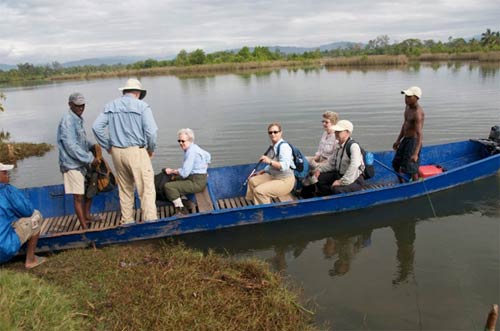
Setting off - blue boat
After breakfast, we walked roughly ten minutes along a sandy road to get the blue long boat that would take us on about a ten minute trip along a canal to a bigger boat in the Maroantsetra harbor. The blue boat itself was about half metal and half rust held together with lots of bright blue paint. Fortunately the water was shallow, so if the boat suddenly crumbled we could have waded ashore. As we puttered along, we came to a pedestrian bridge that was so low to the water we had to bow down nearly flat as if seized by sudden religious fervor to face Mecca. No fingers over the edge. No peeking if you valued your head. Just maintaining a position of deep devotion until all was clear.
Fortunately we got under the bridge quickly and soon landed in the harbor and transferred to a much bigger motor boat, sort of a cabin cruiser without the cabin, which had a reliable inboard engine. As I boarded the boat, I reflected on the reality that in such circumstances the state of the engine is really important. I developed a sudden interest in internal combustion technology. I was hoping that our particular inboard engine had been well maintained, since we were crossing open water for a trip that would take about two hours each way. I tried to peek at the gas gauge, but I couldn’t figure out which one it was. So, I had to give up and just have faith in our crew. Perhaps this was the message of our Mecca devotional earlier
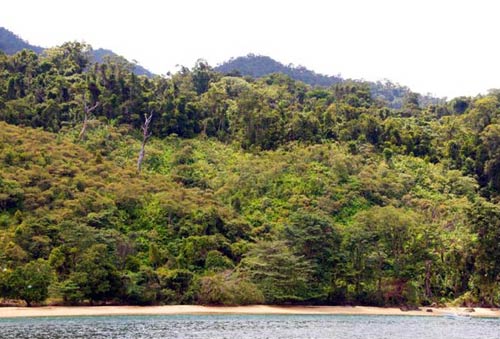
Masoala National Park
Fortunately, my faith was requited and the trip came off without a hitch - not even a hint of a queasy stomach on anyone’s part - and we arrived at the sandy beach that would be our landing point for our trek in Masaola Park.
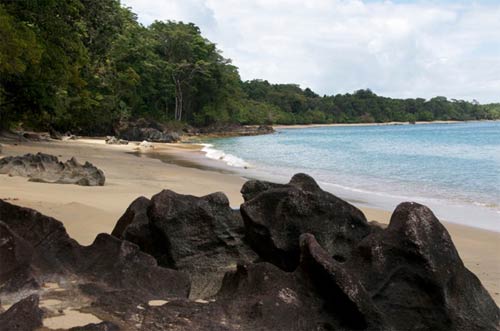
Invitation to swim and nap...
Getting off the boat wasn’t quite as simple as getting on. It was a wet landing since we were coming into a sandy beach. So we changed our hiking boots for flip-flops or water sandals. Then one by one we climbed down a ladder with orange plastic rungs, two of which were history, and then plunked into the water. We all passed the test albeit without total grace and walked onto shore. The last time I did any wet landings, actually the only other time, was on our trip to the Galapagos. Once on the beach, we put on our socks and hiking boots, organized our gear, had a big gulp of water, used the “facilities” in the form of conveniently located plants by the beach, and reported for duty to our guides, Vy and Seraphim I and Seraphim II (Angel I and Angel II).
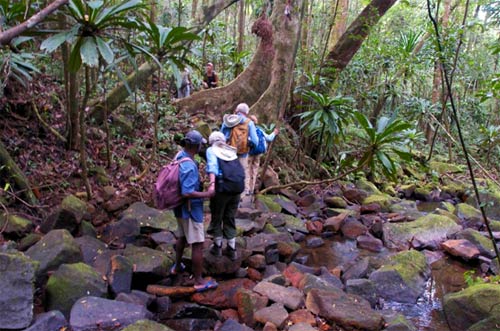
In search of the red-ruffed lemur
We ten ventured into the rainforest and for the next three hours 3 hours explored it - really only its edges considering that the entire island is rainforest - along a series of paths that were mostly rocks, tree roots, streams, old logs, and so forth. Our walking sticks which made a real difference. In one way we were lucky. It wasn’t raining. In fact, we had great weather - sun all the time. It would have been more difficult to clamber up and down on the rocky paths if they had been made slick by rain.
Before coming to Madagascar, I thought that rainforests were so dense at ground level that you had to sort of hack your way in. But it isn’t so. It turns out - and is logical - that younger rainforests can be very dense at low levels because the plants are younger, shorter, and all competing literally for their place in the sun. But by the time they are older, the plants are much taller, competition has sorted them into winners and losers, and too little sun penetrates to ground level to support dense growth low down to human height. So, walking through the forest did not require great machete technique.
I must say that the rainforest to me was impressive in a very profound way. Impressive in capital letters. It’s a celebration of life in a very big way. It’s obvious that when life finally found a way to get going, it went all the way. Given the right environment of oxygen, carbon dioxide, water, sunlight, and warmth, LIFE thrives - and it thrives in thousands of different ways with diverse plants and animals competing individually and collectively to LIVE. And LIVE they do, in so many different ways. Being in the rainforest is a total immersion experience in LIFE. The environment is also a jewel box of individual species each of which has evolved so it can survive.
It would be so engaging to spend the time it would take to tune one’s senses to hear, see, and sense all that is going on, all the time, all around even one single spot in the rainforest, let alone a pathway or a totality. What fun it would be. I felt as if a vast number of life forms had tumbled all around me in some sort of green avalanche. The rainforest is a celebration of what came to be when that first spark of life ignited and LIFE exploded, developed, competed, and evolved for a spell, like a billion years or so.
Not surprisingly, there were more life forms than plants in our rainforest. We were on particular lookout for the rarest lemur of all - the red ruffed lemur. We were lucky and caught sight of roughly a dozen of them frolicking about high in the trees and leaping from limb to limb. They are quite big and often you could see their long bushy tails before you saw the rest of them. Several of us were snapping pictures as fast we could.
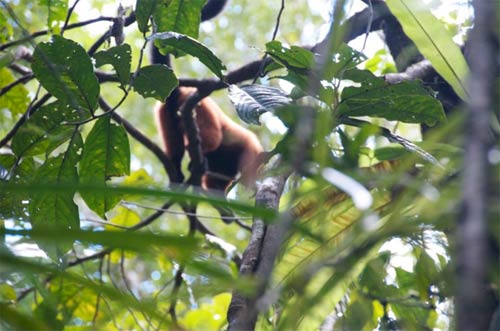
Red ruffed lemur
They also made quite a racket when we got close to their territory. Racket is the informal word. Vocalization is the approved term.
We also were on the lookout for a birds. Top on the list was the Helmet Vanga, which in the words of Frank Almeda looks like “a bird designed by a committee.” Despite all the attempts our guide made to sound like a lovelorn Helmet Vanga, none appeared, so I guess we’ll have to come back someday and try again.
We emerged from the rainforest tuckered, sore here and there, and a bit peckish as well. Lunch was waiting on a tarp on the sand by the beach. Cold chicken, cold pasta, and vegetables, rolls, and plenty of liquids of diverse sorts. We may have failed in our wild Helmet Venga chase, but lunch was partial consolation.
The boat ride back was not quite as smooth as the morning, but not really uncomfortable. We also made better time and the engine never faltered. The long blue boat was waiting at the dock and so we hopped from one boat to the other, ducked under the bridge in gratitude for a great day, and in a few more minutes we were back at the launching place where we began the day.
It had been a terrific day. We were very lucky to have experienced it. But, to the elusive Helmet Vanga - next time we’ll find you!